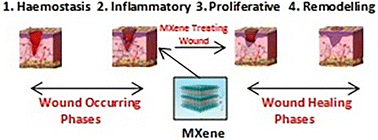MXenes: promising 2D materials for wound dressing applications – a perspective review
Abstract
Two-dimensional (2D) materials have been studied extensively for the past 15 years, sparking a new wave of research on well-known 2D materials. Due to their specific configuration and noteworthy physiochemical features, intensive, multifaceted research attempts have been focused on the medical and clinical applications of 2D materials. In this context, 2D MXenes, a new class of ultra-thin atomic nanosheet materials produced from MAX phase ceramics, are gaining popularity as inorganic nanosystems, especially for biomedical applications. The 2D MXenes can meet the stringent biomedical standards due to their high conductivity, hydrophilicity, and other interesting physicochemical properties. Based on these characteristics, 2D MXenes have been used in wound dressing management and there are many studies on the development of nanofibers and nanosheets. Herein, we present an overview of MXenes, and their synthesis using various processes and properties. The review further focuses on the mechanism and importance of MXenes for wound dressing applications. Additionally, we summarize the toxicity and bio-safety issues of MXene-based materials. In the last section, we present the conclusions, challenges and future outlook.

- This article is part of the themed collection: Recent Review Articles


 Please wait while we load your content...
Please wait while we load your content...